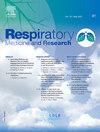Anti-Mi-2 positive interstitial lung disease (ILD): A progressive disease comparable to other myositis-ILD
IF 1.8
4区 医学
Q3 RESPIRATORY SYSTEM
引用次数: 0
Abstract
Background
Evaluation for interstitial lung disease (ILD) often involves sending a myositis panel that includes myositis-associated and myositis-specific antibodies (MAA and MSA respectively) such as anti-Mi-2. Little is known about anti-Mi-2 positive ILD. We sought to determine the typical presentation and prognosis of anti-Mi-2 positive ILD.
Methods
We performed a retrospective chart review of patients in two ILD referral centers in Boston, MA with a positive anti-Mi-2 antibody between 2012 and 2024. Patients were identified by query of the medical record for patients with anti-Mi-2, and we included those with ILD on chest computed tomography (CT). We conducted survival analyses for ILD progression-free and overall survival using Kaplan-Meier curves and log-rank tests. Additionally, a Cox proportional-hazards model was employed, adjusting for age, gender, baseline forced vital capacity, and immunosuppressant use to calculate hazard ratios. The comparator group included patients who were followed longitudinally in the ILD clinic who were anti-Mi-2 negative but positive for other MSAs.
Results
Fifty-eight patients were identified. Half (52 %) were female with mean age 67 years (SD 13 years). The majority had dyspnea and/or cough, and a quarter of patients required oxygen upon presentation. Six (10 %) had PM/DM that pre-dated their ILD diagnosis. Other autoantibody positivity was common; one-third-of patients (n = 19, 33 %) were positive for anti-Mi-2 alone without positivity for other MSAs or MAAs. Clinical follow up data were available for 52 patients for a median follow up of 24 months (range <1 month-10 years). PFT progression was seen in 67 % and radiologic progression was seen in over a third. Half received immunosuppression (55 %), with 19 % requiring multiple immunosuppressives. During follow up, 21 % had acute exacerbation of ILD or death. Progression-free and overall survival were not significantly different among anti-Mi-2 positive ILD versus anti-Mi-2 negative, MSA positive ILD patients regardless of anti-Mi-2 positivity alone or in combination with other autoantibodies.
Conclusions
This series of 58 patients is the largest anti-Mi-2 positive ILD cohort to date. Concurrent positivity with other autoantibodies associated with ILD was common. Anti-Mi-2 positive ILD was associated with similar outcomes to those with other MSAs. Larger studies are needed to better characterize patients with Mi-2 positive ILD.
抗mi -2阳性间质性肺病(ILD):一种与其他肌炎相似的进行性疾病
肺间质性疾病(ILD)的诊断通常包括肌炎检查,包括肌炎相关抗体和肌炎特异性抗体(分别为MAA和MSA),如抗mi -2。对抗mi -2阳性ILD知之甚少。我们试图确定抗mi -2阳性ILD的典型表现和预后。方法:我们对2012年至2024年间在马萨诸塞州波士顿的两家ILD转诊中心抗mi -2抗体阳性的患者进行回顾性图表回顾。通过查询抗mi -2患者的医疗记录来确定患者,并在胸部计算机断层扫描(CT)上纳入ILD患者。我们使用Kaplan-Meier曲线和log-rank检验对ILD无进展和总生存率进行了生存分析。此外,采用Cox比例风险模型,调整年龄、性别、基线强制肺活量和免疫抑制剂使用来计算风险比。比较组包括在ILD诊所纵向随访的抗mi -2阴性但其他msa阳性的患者。结果共鉴定出58例患者。一半(52%)为女性,平均年龄67岁(SD 13岁)。大多数患者有呼吸困难和/或咳嗽,四分之一的患者在就诊时需要吸氧。6例(10%)在ILD诊断之前患有PM/DM。其他自身抗体阳性较为常见;三分之一的患者(n = 19, 33%)单抗mi -2阳性,而其他msa或MAAs阳性。52例患者的临床随访数据为中位随访24个月(范围1个月-10年)。67%的患者出现PFT进展,超过三分之一的患者出现放射学进展。一半接受免疫抑制(55%),19%需要多种免疫抑制剂。在随访期间,21%的患者出现ILD急性加重或死亡。抗mi -2阳性ILD患者的无进展期和总生存率与抗mi -2阴性、MSA阳性ILD患者的无进展期和总生存率无显著差异,无论单独抗mi -2阳性还是联合其他自身抗体。该58例患者是迄今为止最大的抗mi -2阳性ILD队列。与ILD相关的其他自身抗体同时呈阳性是常见的。抗- mi -2阳性ILD与其他msa相关的结果相似。需要更大规模的研究来更好地描述Mi-2阳性ILD患者。
本文章由计算机程序翻译,如有差异,请以英文原文为准。
求助全文
约1分钟内获得全文
求助全文
来源期刊

Respiratory Medicine and Research
RESPIRATORY SYSTEM-
CiteScore
2.70
自引率
0.00%
发文量
82
审稿时长
50 days
 求助内容:
求助内容: 应助结果提醒方式:
应助结果提醒方式:


